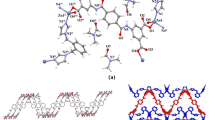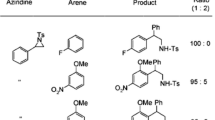Abstract
The syntheses of new cobalt and zinc phthalocyanine complexes containing carbazole (Cz) substituents at the peripheral positions are reported (CzCoPc and CzZnPc). The reaction of Cz with 4-iodophthalonitrile in the presence of a catalytic amount of copper(I) oxide and potassium carbonate led to the formation of 4-(9H-carbazol-9-yl) phthalonitrile. Furthermore, by heating the dinitrile and anhydrous metal salts (CoCl2, Zn(CH3COO)2) at 160 °C in n-hexanol in the presence of DBU, the phthalocyanines were obtained. They were characterised by 1H NMR, FT-IR, UV-Vis and MS spectroscopic data. Aggregation behaviours of Pcs were investigated in THF. Electrochemical redox behaviour of CzCoPc was investigated by cyclic voltammetry depending on the potential range, and the oxidation and reduction products were followed by UV-Visible absorption measurements. Polymerisation of CzCoPc was carried out by potentiodynamic methods on glassy carbon electrode, and the catalytic activity of resulting polymer (P[CzCoPc]) was tested comparatively with polycarbazole (PCz)-coated electrode for dopamine and better response was obtained for P[CzCoPc] modified electrode.



















Similar content being viewed by others
References
Leznoff CC, Lever ABP (1989) Phthalocyanines: properties and application. VCH Publishers, New York
Komatsu T, Ohta K, Fujimoto T, Yamamoto I (1994) Chromic materials. Part 1. Liquid-crystalline behaviour and electrochromism in bis(octakis-n-alkylphthalocyaninato)lutetium(III) complexes. J Mater Chem 4:533–536
Simon J, Sirlin C (1989) Mesomorphic molecular materials for electronics, opto-electronics, ionoelectronics: Octaalkyl-phthalocyanine derivatives. Pure Appl Chem 61:1625–1629
Nazeeruddin MK, Humprey-Baker R, Gratzel M, Murrer BA (1998) Efficient near IR sensitization of nanocrystalline TiO2 films by ruthenium phthalocyanines. Chem Commun 6:719–720
Ragoussi ME, Cid JJ, Yum JH, de la Torre G, Di Censo D, Grätzel M, Nazeeruddin MK, Torres T (2012) Carboxyethynyl anchoring ligands: A means to improving the efficiency of phthalocyanine-sensitized solar cells. Angew Chem Int Ed 51:4375–4378
Perry JW, Mansour K, Lee IYS, Wu XL, Bedworth PV, Chen CT, Ng D, Marder SR, Miles P, Wada T, Tian M, Sasabe H (1996) Organic optical limiter with a strong nonlinear absorptive response. Science 273:1533–1536
Hanack M, Schneider T, Barthel M, Shirk JS, Flom SR, Pong RGS (2001) Indium phthalocyanines and naphthalocyanines for optical limiting. Coord Chem Rev 219–221:235
Lier JEV, Kessel D (1990) Photodynamic therapy of neoplastic diseases, vol 1. CRC Press, Boca Raton
Saydan N, Durmuş M, Dizge MG, Yaman H, Gürek AG, Antunes E, Nyokong T, Ahsen V (2009) Watersoluble phthalocyanines mediated photodynamic effect on mesothelioma cells. J Porphyrins Phthalocyanines 13:681–690
Huang ZA (2005) A review of progress in clinical photodynamic therapy. Technol Canc Res Treat 4:283–293
Arslanoğlu Y, Sevim AM, Hamuryudan E, Gül A (2006) Near-IR absorbing phthalocyanines. Dyes Pigm 68:129–132
Adhikari R, Neckers DC (2010) Carbazole-based emitting compounds. VDM Publishing, Germany
Chakraborty DP (1977) Carbazole Alkaloids in Progress in the chemistry of organic natural products. In: Herz W, Kirby GW (eds) , vol 34. Springer, Wien, pp 299–371
Chakraborty DP, Roy S (1991) Carbazole Alkaloids III in Progress in the chemistry of organic natural products. In: Herz W, Kirby GW (eds) , vol 57. Springer, Wien, pp 71–152
Hagfeldt A, Boschloo G, Sun L, Kloo L, Pettersson H (2010) Dye-sensitized solar cells. Chem Rev 110:6595–6663
Srinivas K, Kumar CR, Reddy MA, Bhanuprakash K, Rao VJ, Giribabu L (2011) D-π-A organic dyes with carbazole as donor for dye-sensitized solar cells. Synth Met 161:96–105
Wang ZS, Koumura N, Cui Y, Takahashi M, Sekiguchi H, Mori A, Kubo T, Furube A, Hara K (2008) Hexylthiophene-functionalized carbazole dyes for efficient molecular photovoltaics: tuning of solar-cell performance by structural modification. Chem Mater 20:3993–4003
Kajiyama S, Uemura Y, Miura H, Hara K, Koumura N (2012) Organic dyes with oligon-hexylthiophene for dye-sensitized solar cells: Relation between chemicalstructure of donor and photovoltaic performance. Dyes Pigm 92:1250–1256
Sundberg RJ (1996) Comprehensive heterocyclic chemistry II. In: Katrizky AR, Rees CW, Scriven EF (eds) , vol 2. Pergamon, Oxford, pp 119–206
Soderberg BCG (2000) Synthesis of heterocycles via intramolecular annulation of nitrene intermediates. Curr Org Chem 4:727–764
Bikram CKC, Subbaiyan NK, D’Souza F (2012) Supramolecular donor−acceptor assembly derived from tetracarbazole−zinc phthalocyanine coordinated to fullerene: Design, synthesis, photochemical, and photoelectrochemical studies. J Phys Chem C 116:11964–11972
Khoza P, Antunes E, Nyokong T (2013) Synthesis and photophysicochemical properties of zinc phthalocyanine derivatized with benzothiazole or carbazole photosensitizers. Polyhedron 61:119–125
Ponce I, Silva JF, Onate R, Rezende MC, Paez MA, Zagal JH, Pavez J (2012) Enhancement of the catalytic activity of fe phthalocyanine for the reduction of o2 anchored to Au(111) via conjugated selfassembled monolayers of aromatic thiols as compared to Cu phthalocyanine. J Phys Chem C 116:15329–15341
İpsiz Ö, Yenilmez HY, Kaya K, Koca A, Bayır ZA (2016) Carbazole-substituted metallo-phthalocyanines: Synthesis, electrochemical, and spectroelectrochemical properties. Syn Met 217:94–101
Gökçe S, Saka ET, Bıyıklıoğlu Z, Kantekin H (2013) Synthesis, characterization of metal-free, metallophthalocyanines and catalytic activity of cobalt phthalocyanine in cyclohexene oxidation. Synt Metals 176:108–115
Kurd M, Hallaj ASR (2013) Highly sensitive amperometric sensor for micromolar detection of trichloroacetic acid based on multiwalled carbon nanotubes and Fe(II)–phtalocyanine modified glassy carbon electrode. Mater Sci Eng C 33:1720–1726
Sezer E, Yavuz Ö, Saraç AS (2000) N-Vinylcarbazole-Acrylamide Copolymer Electrodes, Electrochemical Response to Dopamine. J Electrochem Soc 147:3771–3774
Kawde RB, Laxmeshwar NB, Santhanam KSV (1994) Cyclic voltammetric oxidation of l-dopa at polycarbazole-modified electrode: Evaluation of the cyclization rate constant. Bioelectrochem Bioenerg 34:83–85
Ates M, Castillo J, Sarac AS, Schuhmann W (2007) Carbon fiber microelectrodes electrocoated with polycarbazole and poly(carbazole-co-p-tolylsulfonyl pyrrole) films for the detection of dopamine in presence of ascorbic acid. Mikrochim Acta 160:247–251
Ates M, Sarac AS, Turhan CM, Ayaz NE (2009) Polycarbazole modified carbon fiber microelectrode: surface characterization and dopamine sensor. Fiber Polym 10:46–52
White BM, Rubinson JF (2009) ECS Trans 19:97–103
Kawde R (2015) Development of neurotransmitter sensor using polycarbazole. LAP Lambert Academic Publishing, Germany
Li Y, Song H, Zhang L, Zuo P, Ye BC, Yao J, Chen W (2016) Supportless electrochemical sensor based on molecularly imprinted polymer modified nanoporous microrod for determination of dopamine at trace level. Biosens Bioelectron 78:308–314
Xu H, Xiao J, Yan L, Zhu L, Liu B (2016) An electrochemical sensor for selective detection of dopamine based on nickel tetrasulfonated phthalocyanine functionalized nitrogen-doped graphene nanocomposites. J. Electroanal Chem 779:92–98
Sancy M, Silva JF, Pavez J, Zagal JH (2013) Simultaneous electrochemical detection of dopamine, ascorbic acid and uric acid using copper-phthalocyanine functionalized mwcnts. J Chil Chem Soc 58:2117–2121
Mphuthi NG, Adekunle AS, Fayemi OE, Eno LOO, Ebenso E (2017) Phthalocyanine Doped Metal Oxide Nanoparticles on Multiwalled Carbon Nanotubes Platform for the detection of Dopamine. Scientific Reports 7:43181
Zagal JH, Griveau S, Silva JF, Nyokong T, Bedioui F (2010) Metallophthalocyanine-based molecular materials as catalysts for electrochemical reactions. Coord Chem Rev 254:2755–2791
Neto SY, de Cassia Silva Luz R, Damos FS (2016) Photoelectroanalytical Sensor Based on TiO2 Nanoparticles/Copper Tetrasulfonated Phthalocyanine for Detection of Dopamine Exploiting Light Emitting Diode Irradiation. Electroanal 28:2087–2092
Martin CS, Gouveia-Caridade C, Crespilho FN, Constantino CJL, Brett CMA (2016) Iron Phthalocyanine Electrodeposited Films: Characterization and Influence on Dopamine Oxidation. J Phys Chem C 120:15698–15706
Oni J, Nyokong T (2001) Simultaneous voltammetric determination of dopamine and serotonin on carbon paste electrodes modified with iron(II) phthalocyanine complexes. Anal Chim Acta 434:9–21
Kang TF, Shen GL, Yu RQ (1997) Voltammetric behaviour of dopamine at nickel phthalocyanine polymer modified electrodes and analytical applications. Anal Chim Acta 356:245–251
Griffiths J, Roozpeikar B (1976) Synthesis and electronic absorption spectra of dicyano-derivatives of 4-diethylaminoazobenzene. J Chem Soc Perkin Trans 1:42–45
Marcuccio SM, Svirskaya PI, Greenberg S, Lever ABP, Leznoff CC, Tomer KB (1985) Binuclear phthalocyanines covalently linked through two- and four-atom bridges. Can J Chem 63:3057–3069
Yenilmez HY, Sevim AM, Bayır ZA (2013) Synthesis and photophysics of new metallo phthalocyanine complexes with thiazole groups and their fluorescence quenching studies with benzoquinone. Syn Met 176:11–17
Karaoğlu HRP, Koca A, Koçak MB (2013) The synthesis and electrochemistry of novel, symmetrical, octasubstituted phthalocyanines. Syn Met 182:1–8
Sommerauer M, Rager C, Hanack M (1996) Separation of 2(3),9(10),16(17),23(24)-Tetrasubstituted Phthalocyanines with Newly Developed HPLC Phases. J Am Chem Soc 118:10085–10093
Koca A, Kalkan A, Bayır ZA (2011) Electrocatalytic oxygen reduction and hydrogen evolution reactions on phthalocyanine modified electrodes: Electrochemical, in situ spectroelectrochemical, and in situ electrocolorimetric monitoring. Electrochim Acta 56:5513–5525
Gürol I, Durmus M, Ahsen V, Nyokong T (2007) Synthesis, photophysical and photochemical properties of substituted zinc phthalocyanines. Dalton Trans 34:3782–3791
Kobayashi N, Konami H (1999) In: Leznoff CC, Lever ABP (eds) Molecular Orbitals and Electronic Spectra of Phthalocyanine Analogues in Phthalocyanines: Properties and Applications, vol. 4, Chapter 9, VCH, New York
Law WF, Liu RCW, Jiang J, Ng DKP (1997) Synthesis and spectroscopic properties of octasubstituted (phthalocyaninato)titanium(IV) complexes. Inorg Chim Acta 256:147–150
Ogunsipe A, Maree D, Nyokong T (2003) Solvent effects on the photochemical and fluorescence properties of zinc phthalocyanine derivatives. J Mol Struct 650:131–140
Bayliss NS (1950) The effect of the electrostatic polarization of the solvent on electronic absorption spectra in solution. J Chem Phys 18:292–296
Law WF, Liu RCW, Jiang JH, Ng DKP (1997) Synthesis and spectroscopic properties of octasubstituted (phthalocyaninato)titanium(IV) complexes. Inorg Chim Acta 256:147–150
Simon J, Bossoul P (1989) In: Leznoff CC, Lever ABP (eds) Synthesis and Spectroscopic Properties of Phthalocyanine Analogues in Phthalocyanines: Properties and Applications, Vol. 2. Chapter 3, VCH Publishers, New York
Koca A, Kalkan A, Bayır ZA (2010) You have full text access to this contentElectrochemical, In Situ Spectroelectrochemical, In Situ Electrocolorimetric and Electrocatalytic Characterization of Metallophthalocyanines Bearing Four Dioctylaminocarbonyl Biphenyloxy Substituents. Electroanal 22:310–319
Skotheim TA, Reynolds JR (2007) Handbook of Conducting Polymers, Conjugated Polymers, Third edn. CRC Press, Taylor & Francis Group, UK
Sezer E, Ustamehmetoglu B, Saraç AS (1999) Chemical And Electrochemical Copolymerization Of Pyrrole with N-Substituted Carbazoles, Synt. Metals 107:7–17
Mark HB, Atta N, Ma YL, Petticrew KL, Zimmer H, Shi Y, Lunsford SK, Rubinson JF, Galal A (1995) The electrochemistry of neurotransmitters at conducting organic polymer electrodes: electrocatalysis and analytical applications. Bioelectrochem and Bioener 38:229–245
Vasantha VS, Chen SM (2005) Electrochemical preparation and electrocatalytic properties of PEDOT/ferricyanide film-modified electrodes. Electrochimica Acta 51:347–355
Mathiyarasu J, Senthilkumar S, Phani KLN, Yegnaraman V (2008) PEDOT-Au nanocomposite film for electrochemical sensing. Mater Lett 62:571–573
Funding
This work was supported by Research Funds of Istanbul Technical University.
Author information
Authors and Affiliations
Corresponding author
Rights and permissions
About this article
Cite this article
Yenilmez, H., Ustamehmetoğlu, B., Sezer, E. et al. The synthesis and electrochemical behaviour of carbazole-substituted phthalocyanines. J Solid State Electrochem 22, 505–517 (2018). https://doi.org/10.1007/s10008-017-3779-9
Received:
Revised:
Accepted:
Published:
Issue Date:
DOI: https://doi.org/10.1007/s10008-017-3779-9




